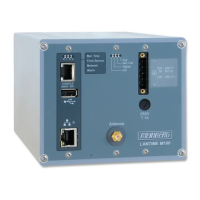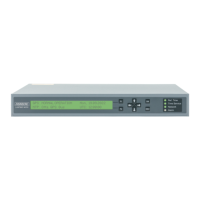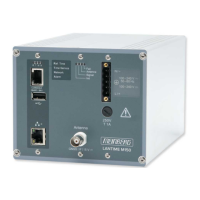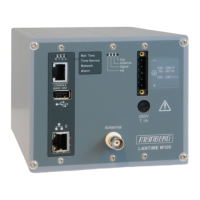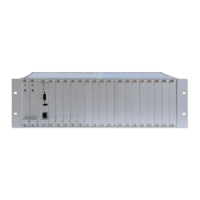Do you have a question about the Meinberg LANTIME and is the answer not in the manual?
Explains operational states, synchronization, and failure modes of the LANTIME/SHS system.
Lists network protocols and services supported by the LANTIME unit for connectivity.
Details extra functionalities and hardware options enhancing LANTIME capabilities.
Explains methods for interacting with and controlling the LANTIME system.
Outlines optional hardware extensions and configurations available for LANTIME.
Describes the hardware features and specifications of the GPS167 receiver.
Explains how LANTIME handles time zones and daylight saving adjustments.
Provides instructions for assembling the GPS antenna with the CN-UB/E component.
Details display messages and troubleshooting for an antenna line short-circuit.
Describes the capabilities and specifications of the PZF5xx DCF77 module.
Guides on optimal placement and installation of the PZF5xx antenna for reception.
Explains the startup process and synchronization of the GPS receiver.
Details the initialization sequence for the LANTIME's internal computer system.
Describes the components and functions of the LANTIME's front panel interface.
Explains the initial display screen and status indicators after system initialization.
Shows the status of the Secure Hybrid System and time deviation alerts.
Displays the current geographical coordinates and position data of the receiver.
Provides an overview of visible satellites and their geometric constellation precision.
Shows detailed information about individual satellites, including elevation and azimuth.
Allows users to access and modify system parameters and operational modes.
Configures the maximum acceptable time difference for the hybrid system.
Sets up network configuration including IP address, netmask, and gateway.
Adjusts specific parameters for the PZF5xx receiver module.
Configures local time zone settings and daylight saving offsets.
Defines the dates and times for daylight saving transitions.
Configures baud rate and framing for serial RS232 communication.
Selects the format for serial time string output.
Sets the initial approximate position to speed up satellite acquisition.
Allows manual setting of the system's real-time clock for initialization.
Enables running without antenna by fixing GPS status to SYNC.
Initializes all GPS data, clearing saved satellite information.
Forces the receiver into a boot mode to re-read satellite data.
Specifies the length of the antenna cable for delay compensation.
Resets GPS parameters to factory defaults, clearing memory.
Explains the function of the status LEDs on the PZF509 front panel.
Describes the alphanumeric display for status and time information on PZF509.
Details the function of the PZF509's navigation buttons.
Lists the available menus and information displayed on the PZF509.
Explains how to access and use the LANTIME's web-based configuration interface.
Configures network settings specific to each Ethernet port.
Configures link aggregation for increased network reliability and fault tolerance.
Sets up different notification types for various system events and errors.
Configures sender/receiver addresses and SMTP server for email notifications.
Sets up notifications to be sent as Windows popup messages.
Configures hosts for receiving SNMP traps for status monitoring.
Sets up alarm message display on optional VP100/NET units.
Allows defining custom scripts for handling specific events.
Customizes the text of alarm messages for different events.
Manages the administration password for secure access to the timeserver.
Restricts web interface access based on host IP addresses.
Configures secure shell access and key generation for remote administration.
Creates or uploads SSL certificates for secure HTTPS connections.
Generates crypto keys and certificates for secure NTP operation.
Configures parameters related to SNMP agent functionality.
Provides system management functions like rebooting and manual configuration.
Manages user accounts, passwords, and group memberships for administration.
Displays system logs and version details accessible via CLI.
Presents graphical data and statistics on the synchronization process and system performance.
Configures network interfaces and protocols via the command line interface.
Sets up notification types for various system events via CLI.
Manages the administration password for SSH, Telnet, FTP, HTTP, and HTTPS access.
Configures secure shell access and key generation for remote administration.
Creates or uploads SSL certificates for secure HTTPS connections.
Manages crypto keys and certificates for secure NTP operation.
Configures authentication methods for NTP communication.
Manages AUTOKEY feature for NTP client authentication.
Provides system management operations like rebooting and factory reset via CLI.
Manages user accounts and group memberships through the CLI.
Displays system logs and version details accessible via CLI.
Demonstrates how to use SNMP tools to configure the timeserver.
Explains advanced SNMP configuration options and daemon customization.
Details commands that can be sent via SNMP to control the timeserver.
Provides a reference table for SNMP configuration variables and MIBs.
Lists and describes SNMP traps sent by the timeserver for event notifications.
Safety precautions and instructions for replacing the internal lithium battery.
Outlines the technical specifications and physical dimensions of the LANTIME BGT.
Provides safety guidelines for installing the equipment in an application.
Lists relevant certifications and standards for the device.
Details standards related to electromagnetic emission and immunity.
Details the frequency accuracy of the TCXO quartz oscillator.
Provides specifications for the GPS167 antenna, including dimensions and power requirements.
Describes the signals and pin assignments for the GPS167 module.
Lists the pin assignments for the rear panel connectors of the GPS167.
Details the signals and pin assignments for the PZF5xx module.
Lists the pin assignments for the rear panel connectors of the PZF5xx.
Details pin assignments for the rear connectors of the LAN CPU.
Specifies pin assignments for VGA and keyboard connectors.
Describes the format of the standard Meinberg time string output.
Details the ASCII format of the GPS167 capture string.
Explains the format of the SAT-Time string for time synchronization.
Describes the format of the Uni Erlangen time string for NTP synchronization.
Specifies the format of the NMEA 0183 RMC string for GPS data.
Details the format of the ABB SPA time string output.
Explains the format of the COMPUTIME time string.
Information about the GNU/Linux operating system and its license.
Details the Samba software suite for Windows network integration.
Provides a summary of time code transmission and its development.
Explains how the GPS167-TC board generates time codes.
Illustrates the functional blocks involved in time code generation.
Details the structure and timing of the IRIG Standard time code.
Describes the format and timing of the AFNOR Standard time code.
Explains the bit assignments within the IEEE1344 time code standard.
Lists the different types of time codes that can be generated by the board.
Guides on how to select the desired time code output format.
Describes the output signals and formats for time codes.
Explains the directory and file structure required for USB stick configuration.
Describes how to define submenus and script files for USB stick operation.
Details the purpose and content of script files used with the USB stick.
Explains how to use the USB stick to lock the Lantime's keypad.
| Category | NTP Time Server |
|---|---|
| Protocols | NTP, SNTP |
| Synchronization | GPS, GLONASS |
| Form Factor | Rack-mountable |
| Redundancy | Optional redundant power supply |
| Type | Network Time Server |
| Operating Temperature | 0°C to 50°C |
| GPS Receiver | Yes, integrated GPS receiver (GLONASS, Galileo, BeiDou optional) |



